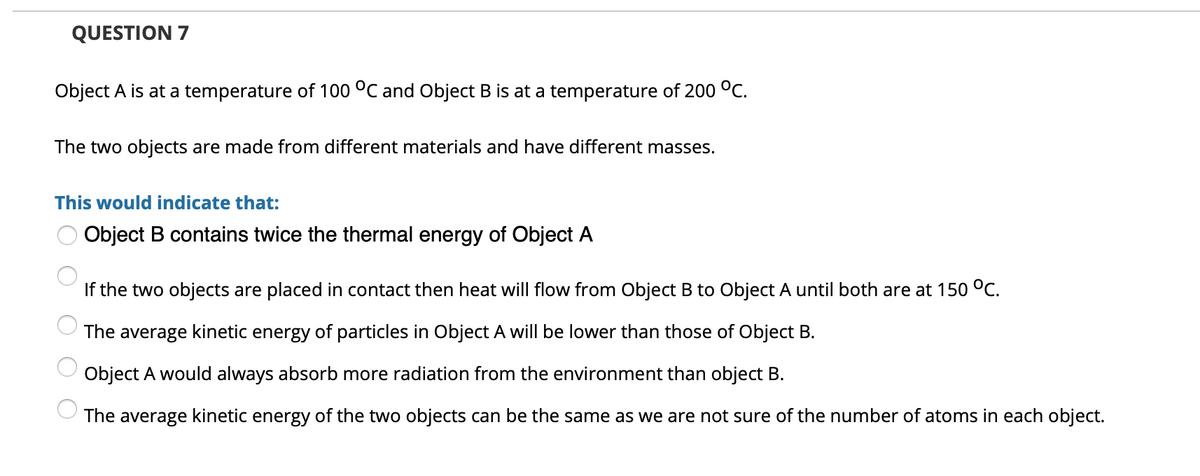Object A is at a temperature of 100 °C and Object B is at a temperature of 200 C. The two objects are made from different materials and have different masses. This would indicate that: Object B contains twice the thermal energy of Object A If the two objects are placed in contact then heat will flow from Object B to Object A until both are at 150 °c. The average kinetic energy of particles in Object A will be lower than those of Object B. Object A would always absorb more radiation from the environment than object B. The average kinetic energy of the two objects can be the same as we are not sure of the number of atoms in each object.
Object A is at a temperature of 100 °C and Object B is at a temperature of 200 C. The two objects are made from different materials and have different masses. This would indicate that: Object B contains twice the thermal energy of Object A If the two objects are placed in contact then heat will flow from Object B to Object A until both are at 150 °c. The average kinetic energy of particles in Object A will be lower than those of Object B. Object A would always absorb more radiation from the environment than object B. The average kinetic energy of the two objects can be the same as we are not sure of the number of atoms in each object.
College Physics
10th Edition
ISBN:9781285737027
Author:Raymond A. Serway, Chris Vuille
Publisher:Raymond A. Serway, Chris Vuille
Chapter11: Energy In Thermal Processes
Section11.5: Energy Transfer
Problem 11.4QQ: Two rods of the same length and diameter are made from different materials. The rods are to connect...
Related questions
Question
question in photo please asap

Transcribed Image Text:QUESTION 7
Object A is at a temperature of 100 °C and Object B is at a temperature of 200 °C.
The two objects are made from different materials and have different masses.
This would indicate that:
Object B contains twice the thermal energy of Object A
If the two objects are placed in contact then heat will flow from Object B to Object A until both are at 150 °c.
The average kinetic energy of particles in Object A will be lower than those of Object B.
Object A would always absorb more radiation from the environment than object B.
The average kinetic energy of the two objects can be the same as we are not sure of the number of atoms in each object.
O O O
Expert Solution
This question has been solved!
Explore an expertly crafted, step-by-step solution for a thorough understanding of key concepts.
This is a popular solution!
Trending now
This is a popular solution!
Step by step
Solved in 2 steps

Knowledge Booster
Learn more about
Need a deep-dive on the concept behind this application? Look no further. Learn more about this topic, physics and related others by exploring similar questions and additional content below.Recommended textbooks for you

College Physics
Physics
ISBN:
9781285737027
Author:
Raymond A. Serway, Chris Vuille
Publisher:
Cengage Learning

College Physics
Physics
ISBN:
9781938168000
Author:
Paul Peter Urone, Roger Hinrichs
Publisher:
OpenStax College

Physics for Scientists and Engineers, Technology …
Physics
ISBN:
9781305116399
Author:
Raymond A. Serway, John W. Jewett
Publisher:
Cengage Learning

College Physics
Physics
ISBN:
9781285737027
Author:
Raymond A. Serway, Chris Vuille
Publisher:
Cengage Learning

College Physics
Physics
ISBN:
9781938168000
Author:
Paul Peter Urone, Roger Hinrichs
Publisher:
OpenStax College

Physics for Scientists and Engineers, Technology …
Physics
ISBN:
9781305116399
Author:
Raymond A. Serway, John W. Jewett
Publisher:
Cengage Learning

Physics for Scientists and Engineers
Physics
ISBN:
9781337553278
Author:
Raymond A. Serway, John W. Jewett
Publisher:
Cengage Learning

Principles of Physics: A Calculus-Based Text
Physics
ISBN:
9781133104261
Author:
Raymond A. Serway, John W. Jewett
Publisher:
Cengage Learning

Physics for Scientists and Engineers with Modern …
Physics
ISBN:
9781337553292
Author:
Raymond A. Serway, John W. Jewett
Publisher:
Cengage Learning